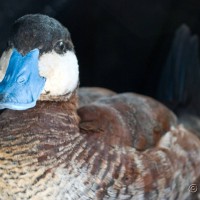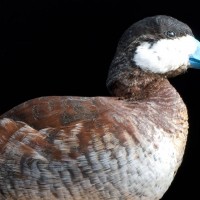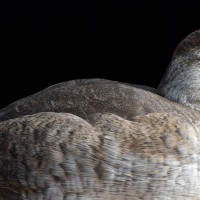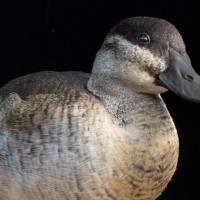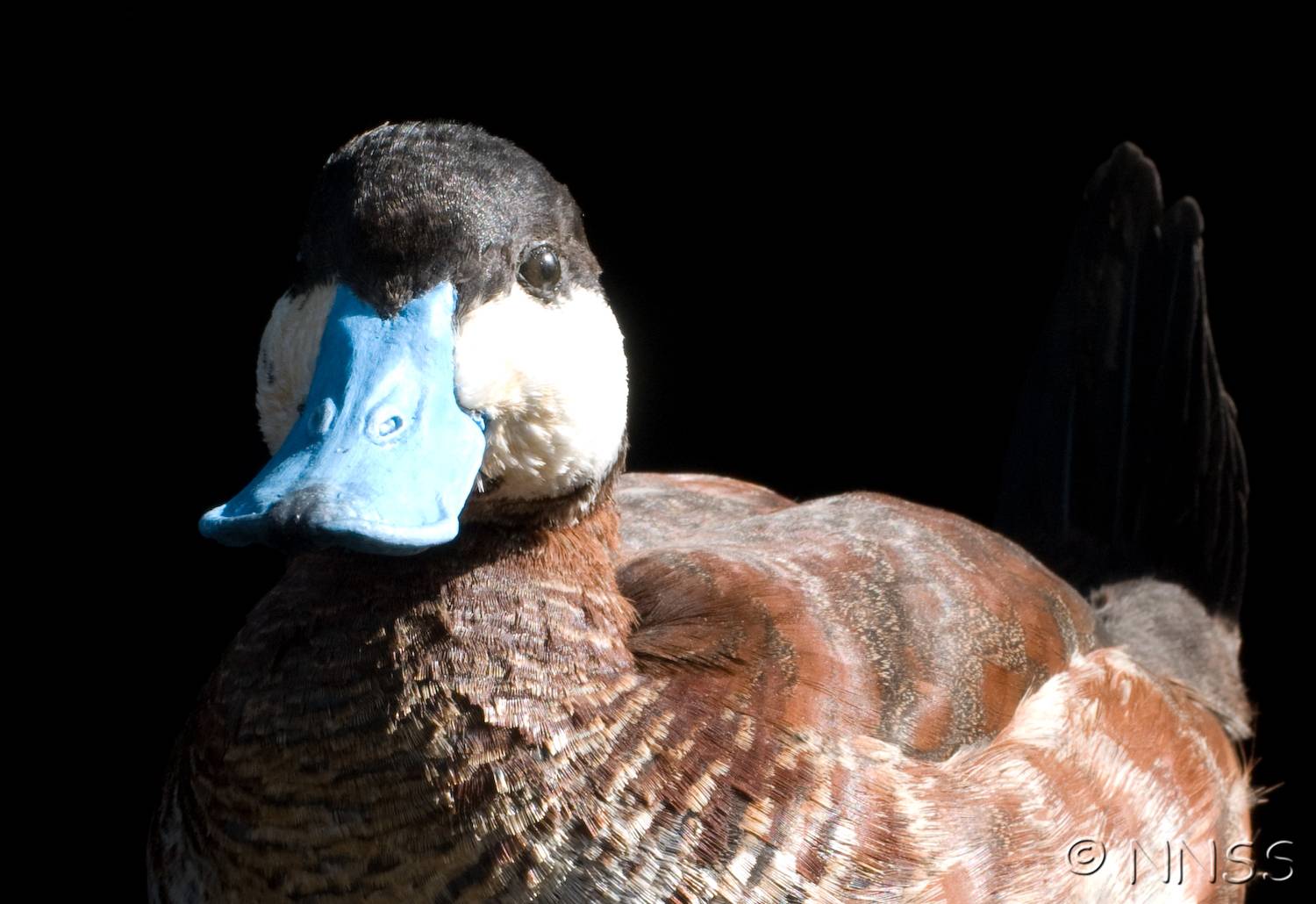
Ruddy Duck - Oxyura jamaicensis
Expand and collapse the sections below by clicking on the title or + / - icons.
Short description of Oxyura jamaicensis, Ruddy Duck
A diving duck with a dumpy, short-necked shape and a longish tail, sometimes held upright. Males are chestnut-red with white cheeks and a swollen, bright blue bill. Females are brown with a dark cap and a horizontal dark bar across the cheek.
Impact summary: Oxyura jamaicensis, Ruddy Duck
Ruddy ducks from introduced populations in Europe have invaded the range of white-headed ducks Oxyura leucocephalus, their native European relative, in Spain, and are threatening that endangered species through introgressive hybridisation and competition.
Habitat summary: Oxyura jamaicensis, Ruddy Duck
Ruddy ducks nest at fresh water bodies that have extensive emergent reeds and winter mainly in substantial flocks on large lakes or reservoirs.
Overview table
| Environment | Terrestrial and Freshwater |
|---|---|
| Species status | Non-Native |
| Native range | Western Canada, Northwestern U.S.A., North-Central U.S.A., Northeastern U.S.A., Southwestern U.S.A., South-Central U.S.A., Southeastern U.S.A., Mexico, Labrador, New Brunswick, Newfoundland, Nova Scotia, Ontario, Québec, Alaska United States |
| Functional type | Omnivore |
| Status in England | Non-Native |
| Status in Scotland | Non-Native |
| Status in Wales | Non-Native |
| Location of first record | Slimbridge |
| Date of first record | 1952 |
Origin
The native range extends across all of North America north to southern Alaska and southern Canada, and south to Mexico and the Caribbean. Further populations, sometimes treated as separate species, occur in the Andes, from Colombia to Tierra del Fuego.
First Record
Ruddy ducks were first seen in the wild in GB in 1952, and nesting began in the former county of Avon in 1960.
Pathway and Method
GB ruddy ducks have their origin in the import of the species for aviculture since the 1940s. Around 70 birds, chicks raised but left unpinioned, are thought to have escaped from the Slimbridge Wildfowl Trust collection during 1956–63.
Species Status
The GB population had reached an estimated 6,000 birds by 2000. The annual growth rate is estimated to have been 24% during 1976–96. By 1988–91, birds were breeding almost throughout England and Wales, in eastern Scotland and also in Northern Ireland and Ireland . Birds breeding in France, Spain and the Netherlands are believed to have originated from GB. The species is considered to be invasive in Spain, where it hybridises with the native white-headed duck. Eradication across Europe is expected to be complete by 2015.
Dispersal Mechanisms
Though only partly migratory, ruddy duck makes both exploratory and regular seasonal movements, and readily establishes new breeding sites. All records of ruddy ducks east of the Atlantic Ocean, from Iceland and Ireland south to Morocco and east to Finland, Turkey, Israel and Tunisia, are thought to stem from introduced populations, mainly from GB.
Reproduction
Females build floating nests hidden among emergent vegetation, sometimes at ponds smaller than half a hectare. Most broods hatch in July. Interbreeding with white-headed ducks occurs readily and produces fertile hybrids.
Known Predators/Herbivores
Raptors such peregrine may take adult birds, and ducklings are vulnerable to a wider range of predators.
Resistant Stages
None known.
Habitat Occupied in GB
In the breeding season, ruddy ducks are widely dispersed at fresh water sites, with a strong preference for those with a wide reedy fringe. In winter, large numbers of birds congregate on known traditional sites. For example, in January 2000, 83% of the GB population was recorded on only 25 sites, with 67% occurring on only ten sites.
The GB population has been very much reduced by culling, which began in 1999.
Environmental Impact
Ruddy ducks have posed a major threat to the Spanish population of the endangered white-headed ducks, through introgressive hybridisation and competition. Within GB, the ruddy duck appears to occupy a vacant niche, although there may have been some competition with other duck species at the peak of its population.
Health and Social Impact
None known.
Economic Impact
None known.
Identification
Svensson, L., Mullarney, K. & Zetterström, D. (2010) Collins Bird Guide. Second edition. HarperCollins, London.
BirdLife International fact sheet
BirdLife International fact sheet for white-headed duck
Biology, ecology, spread, vectors
Callaghan, D.A., Worth, N., Hughes, B. & Brouwer, K. (1997) European census of captive North American Ruddy Ducks Oxyura j. jamaicensis. Wildfowl, 48, 188–193.
Hughes, B., Underhill, M. & Delany, S. (1998) Ruddy ducks breeding in the United Kingdom in 1994. British Birds, 91, 336–353.
Sanchez, M.I., Green, A.J. & Dolz, J.C. (2000) The diets of the White-headed Duck Oxyura leucocephala, Ruddy Duck O. jamaicensis and their hybrids from Spain. Bird Study, 47, 275–284.
Management and impact
UK eradication project: https:secure.fera.defra.gov.uknonnativespeciesindex.cfm?pageid=244
Banks, A.N., Wright, L.J., Maclean, I.M.D., Hann, C., Mellan, H.J. & Rehfisch, M.M. (2009) Review of the status of introduced non-native waterbird species in the area of African–Eurasian Waterbird Agreement: 2007 update. Research Report 489. BTO, Thetford.
Henderson, I.S. (2006) Recent measures to control Ruddy Ducks Oxyura jamaicensis in the United Kingdom. In Waterbirds around the world (eds G.C. Boere, C.A. Galbraith & D.A. Stroud), pp. 822–825. The Stationery Office, Edinburgh, UK. (link here)
Henderson, I. (2009) Progress of the UK Ruddy Duck eradication programme. British Birds, 102, 680–690.
Hughes, B. (1996) Feasibility of control measures for North American ruddy ducks in the UK. DETR, London.
Smith, G.C., Henderson, I.S. & Robertson, P.A. (2005) A model of ruddy duck Oxyura jamaicensis eradication for the UK. Journal of Applied Ecology, 42, 546–555.
General
Lever, C. (2009) The Naturalized Animals of Britain and Ireland. New Holland Publishers, London.
https://www.cabi.org/isc/datasheet/71368
https://secure.fera.defra.gov.uk/nonnativespecies/downloadDocument.cfm?id=1412
Alert status
Ruddy Duck, Oxyura jamaicensis is an Alert Species
Find more information about this alert and the full list of alert species.
Spotted this species?
Distribution map
View the Distribution map for Ruddy Duck, Oxyura jamaicensis from NBN Atlas

Native range map
View an interactive native range map for Ruddy Duck, Oxyura jamaicensis
ID Sheet
ID Sheet for Oxyura jamaicensis . See a full list of non-native species ID Sheets.
Risk assessment
Risk assessment for Oxyura jamaicensis. See a full list of non-native species Risk assessments.
Legislation
Oxyura jamaicensis is a Species of Special concern. Read more about Non-native species legislation.
Listen to Ruddy Duck


